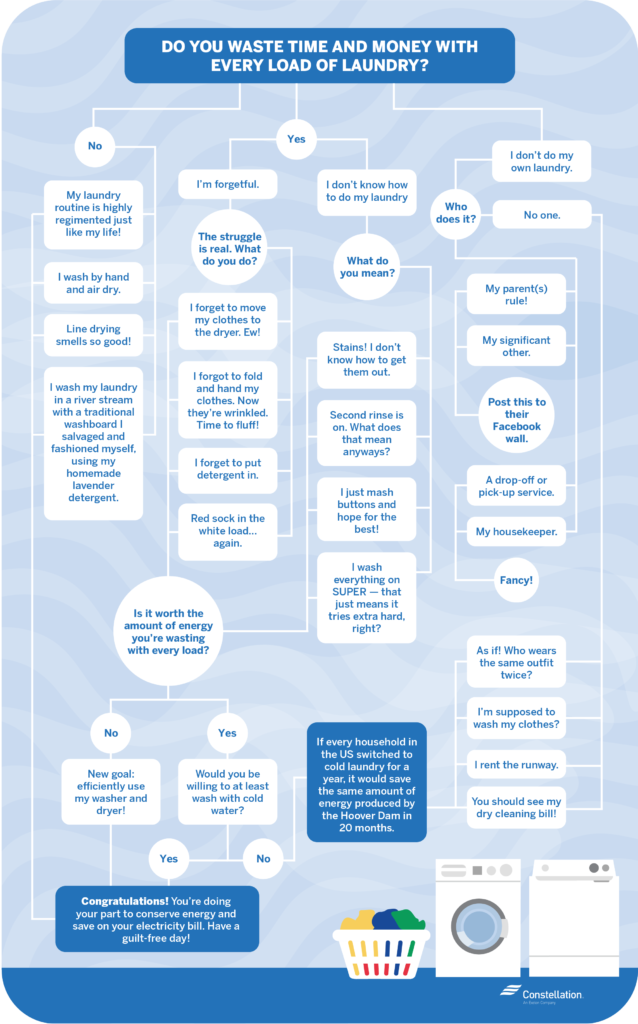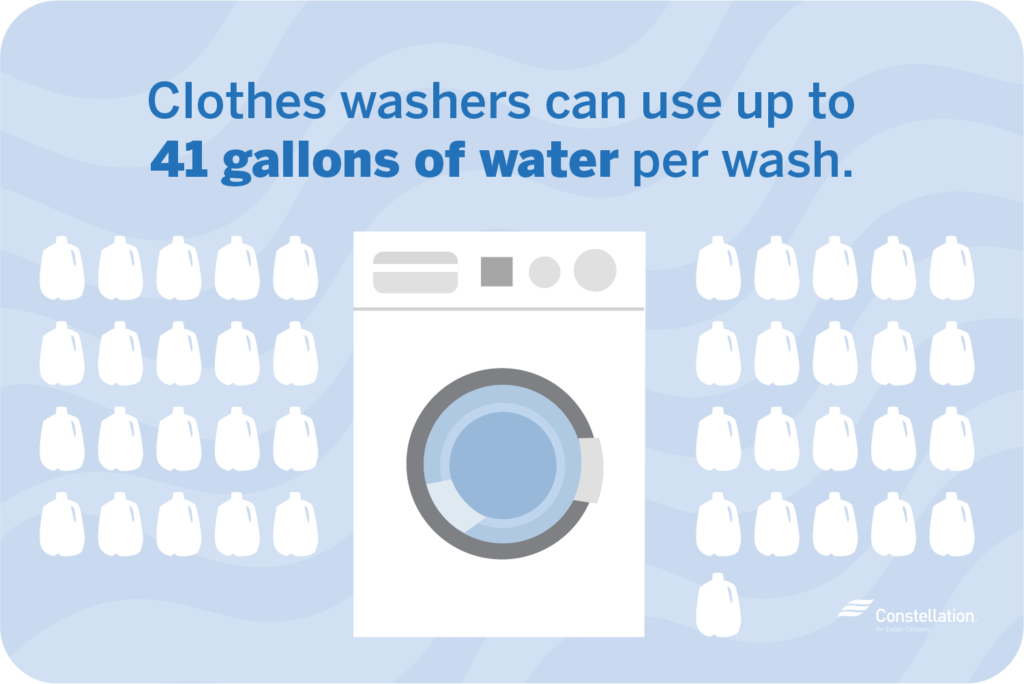
- Category:
Home Energy Savings -
Last updated:
April 16, 2025
Saving Energy on Laundry Day
Laundry is one of life’s unavoidable chores — and it’s a chore that most people do weekly, if not daily. This means that washer and dryer energy usage, coupled with the amount of water used for laundry, can have a direct impact on your energy bills. Choosing the best time to do laundry and following laundry energy-saving tips can reduce your home’s energy consumption.
Do you waste time and money with every load of laundry?
Understanding how your current habits affect washer energy usage is the first step toward a more energy-efficient laundry system. This includes taking note of whether you wash small vs. large loads of laundry, how often you wash clothing, when you do laundry and other factors.
The handy laundry flowchart below will help you identify your laundry habits. From there, you can adjust how you wash clothes to reduce your washer and dryer energy usage.

A typical family of four in the United States averages 300 loads of laundry annually, which accounts for 15% to 40% of a household’s water consumption. Even if you’re more of a laundry minimalist, perhaps doing only two loads a week, or even one, the reality is that washer energy usage is nevertheless still a big part of any household’s energy costs. Residential laundry machines also use more energy annually than dishwashers, although they use less than refrigerators.
All of this means that knowing the energy cost of a load of laundry could be a savvy step toward potentially lowering your monthly energy costs. Here are some laundry energy-saving tips to get you started.
Should I wash my clothes in warm water?
Washing machine energy consumption depends on whether you have the water temperature set to hot or cold. On the hot setting, 90% of the energy a washing machine consumes is spent heating water and only 10% is used to run the motor. Most clothing can be properly washed on the cold setting, especially when you use cold-water detergents.
Consumer Reports notes that washing your clothes in cold water could save you $60 a year (assuming an average of 300 loads). While that might not sound like a lot, imagine if everyone did that.
Washing in cold water is also more than just a smart laundry energy-saving tip. Lower temperatures can help your clothes last longer by protecting dyes and preventing shrinkage.
How much does it cost to run a washing machine?

The average washing machine needs 350 to 500 watts of electricity per use. If you’re washing two loads of laundry a week, that translates into 36,400 to 52,000 watts each year. A family of four may need to wash 5 or more loads of laundry a week, resulting in annual washer energy usage of up to 130,000 watts or more.
Obviously, part of the cost to run a washing machine comes from heating the water, but washer energy usage can also be affected by the type of washing machine you use. Front-loading machines, for instance, are more energy-efficient than top-loading machines.
How much water does a washing machine use?
Electricity alone doesn’t account for laundry’s impact on available resources. To get a clearer picture, you must ask how much water a washing machine uses. If your washing machine is an older model, it could use up to 41 gallons of water per load. If your washing machine is a newer model, it could use up to 23 gallons per load. So if youwash5 loads of clothes a week, your washing machine could consume 10,660 gallons of water per year if it’s an older model, or 5,980 gallons of water per year if it’s a newer model.
The washer energy usage can also be affected by the type of washing machine. Front-loading machines, for instance, are more energy-efficient than top-loading machines. And front-loading machines use 40-75% less water and 30-85% less energy than typical top-loaders, depending on the machine.

How much energy does a dryer use?
Just as you have to consider how much water a washing machine uses to gain a complete view of laundry’s energy consumption, you also need to think about its counterpart appliance: How much energy does a dryer use?
The average residential clothes dryer requires between 1,800 and 5,000 watts per use, making your dryer energy usage higher than that of your washing machine. Clothes dryers are responsible for approximately 6% of the average house’s energy use.
Switching to a more energy-efficient natural gas dryer can reduce your laundry energy use. Check out more energy-saving facts about your dryer to conserve as much energy as possible.
When is the best time to do laundry?

When you choose to do laundry has an impact on how much energy your washer and dryer consume. The best time to wash clothes to save energy is usually outside peak demand hours. In most locations, this means using your washing machine before 12 p.m., or waiting to wash your clothes until after 7 p.m.
Other laundry energy-saving tips
In addition to capitalizing on the best time to do laundry, there are other ways to reduce the energy costs associated with washing and drying clothes.
Energy-saving tips for your washer
- Use high-efficiency detergent. Traditional laundry detergent produces excessive amounts of suds. When used in modern washing machines, which use only 11 to 14 gallons of water per load. When excess suds are not removed they can interfere with the tumbling action used to clean clothes. This forces your washing machine to work harder, potentially causing mechanical problems. High-efficiency detergents are designed for today’s water-conserving washing machines.
- Wash when you’ve got a full load. When it comes to small vs. large loads of laundry, a full load is the more energy-efficient option. If you need to do a smaller load, be sure to choose the appropriate size setting on your washing machine. Too often, consumers select “large” and never change it. Even for energy-efficient front-loaders, that can be a waste. The same goes for dryer energy usage. Dry only full loads, and try to dry two or more loads in a row to take advantage of retained heat from the previous drying cycle.
- Think ENERGY STAR®️. The average full-size front-loading ENERGY STAR®️ clothes washer uses about 15 gallons of water per load, compared to about 23 gallons per load for a top-loading clothes washer without an ENERGY STAR®️ label. ENERGY STAR®️–approved washing machines also provide improved water energy usage because of their larger tub capacity, according to the Consumer Energy Center. The improved capacity means you can wash the same amount of laundry but in fewer loads and with less water.
- Look for smart appliances. Smart washers and dryers can connect to other smart devices and allow you to monitor your energy use. Smart appliances can be set to turn on and off automatically at specific times so you can take advantage of off-peak energy hours.
- Separate clothes and dry similar clothes together. It makes sense that the energy cost of a load of laundry will increase if you don’t pay attention to the types of clothing that are tossed in the dryer together. Synthetics, after all, dry far more quickly than bath towels.
- Use your high spin cycle. Your washer’s high spin cycle reduces how much water clothing retains after washing. This in turn reduces the amount of energy your dryer uses to dry your clothes.
Energy-saving tips for your dryer
- Set up sensor drying if you have it. Overdrying clothes is a waste of energy. If your dryer has a sensor drying function, use it to detect low moisture levels so you aren’t tumble-drying and heating already dry clothes.
- Clean your lint filter. Clean your dryer’s lint filter every time you dry a load of laundry. Doing so improves airflow and dryer efficiency while reducing the risk of fire. Dryer lint is extremely flammable and can combust in hot environments.
- Use your low heat setting. It seems counterintuitive, but ENERGY STAR®️–certified dryers use less energy when set to longer, low heat settings. Check your dryer manual to discover which settings and cycles use the least energy.
- Run your dryer at night. Dryers emit heat, which puts pressure on your HVAC system. To reduce the effect a dryer has on your home environment, run it at night when temperatures are lower.
- Choose natural gas over electric. According to EnergyStar.gov, 80% of dryers in the United States are electric. Natural gas dryers heat up and dry clothing faster, shortening load times and reducing energy consumption.
- Use a drying rack. Air-drying clothes on indoor clothing racks or outdoor clotheslines is the most cost-effective way to reduce laundry energy consumption. Air-drying may take longer, however, and the effectiveness of drying clothes outdoors, it goes without saying, is dependent on the weather.
Tips for using a tumble dryer
Regardless of whether you choose a gas or electric dryer, careful operation can cut energy costs and extend the useful life of your appliance. Here are some laundry energy-saving tips:
- Keep the dryer in a heated space. Dryers in an unheated garage or basement work harder to produce enough heat to dry your clothes, which is less efficient.
- Clean the lint filter regularly. Air flows easier when the filter isn’t clogged with lint. Cleaning your lint filter can also help prevent fires.
- If you use dryer sheets, you should also scrub the lint filter. These sheets can leave a film on the filter which reduces its performance. Giving it a good scrubbing with an all-purpose cleaner and a toothbrush every month keeps your filter working well.
- Don’t ignore the outside dryer vent. Check it periodically to make sure it closes tightly so that outside air does not leak in.
- Dry only full loads. By doing this you’ll optimize energy use. Be careful not to overload the dryer. You need enough air circulating through your clothes to dry them.
- Dry similar types of clothes together. Lightweight synthetics dry more quickly, especially when not lumped in with heavy cotton towels.
- Dry two or more loads in a row. You can take advantage of a dryer’s retained heat when you do one load right after the other.
- Use the cool-down perma-press cycle. Your clothes finish drying with residual heat rather than creating new heat.
You’ve learned all about our laundry energy-savings tips. Now get the details on saving energy for lighting, thermostats and showers as well. Plus, check out our fun Energy Hacks videos on washing and drying energy-savings tips.




